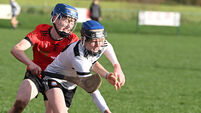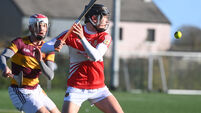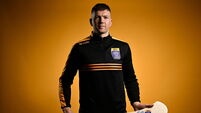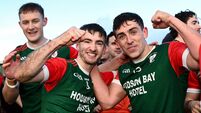Paul Rouse: The loss of the GOAL Challenge Match a great loss to the GAA

Shane O'Donnell is mobbed by young fans at Clare's GOAL Challenge match in Sixmilebridge after the 2013 All-Ireland final. Picture: Eamon Ward
The absence of a charity match played to raise money for GOAL is something to be lamented in the week after an All-Ireland final.
Whether the competing players feel that lament is a moot point: it cannot have been entirely easy to pull on a pair of togs and run around in apparent competition after several days of excess.
One of the men who did it was John Divilly, who starred at centre back when Galway won the All-Ireland Football Championship in 1998: “In 1998 we played Mayo on the Wednesday after the final in Tuam Stadium. We weren’t exactly ready to play a match. On the Monday after the final we had got the train back to Athlone. Ray Silke carried the cup across the Shannon. It took half an hour to cross the bridge it was that full of people. We then went on a bus tour. We stopped in Ballinasloe and Caltra and Mount Bellew and Moylough and Barnadearg and Tuam. It was one big party.
“There were enormous crowds everywhere. It meant that we didn’t get into Eyre Square in Galway city until 2am. We had a sit-down meal at 3am. And then it was on the following day and we started bringing round the cup. It was brilliant, just great fun. But it meant that by the time we played the GOAL match on the Wednesday night we were in no fit state to play a game of football. The first 15 from the final started and then there was a change at half-time with the panel coming in. Mayo didn’t really see it as a charity challenge match though. They clapped us onto the field and then got stuck into us. You’d have to say that they were very, very competitive about it!
“I was happy to play in the game because it was for a great cause and it was a tradition by then and it was a great way for us to meet supporters who we hadn’t seen in the madness of Monday. That was great. But playing the match itself was a fair struggle.”
For those struggling to remember the pre-Covid world, the GOAL Challenge match had evolved into a fundraising match played by the victorious All-Ireland champions in the week after an All-Ireland final. Sometimes they simply played A versus B matches; on other occasions they played the reigning county champions.
Before that – back in the 1980s – the defending All-Ireland champions had played matches against a Rest of Ireland Selection. There was something truly brilliant about these matches.
Men who had sought to tear each other apart now joined in a good cause – one that placed in context the mere winning or losing of a match.
An example is the 1988 match where Meath beat the Rest of Ireland team managed by Mick O’Dwyer by a point. The programme for that match carries the legend: “GOAL scores against poverty”.
GOAL is a charity that was founded in 1977 by John O’Shea, a sports journalist who acted as CEO of the charity until 2012. In the programme to that 1988 GOAL Challenge Match he laid out his basic motivations and made a powerful appeal to people to support his mission.
He said: “What kind of human race is it that permits 20,000 children to perish every day from starvation, malnutrition and related diseases? In a world which is technologically more advanced than ever before in its exitence, we appear to show scant regard for our most precious possession – children.
Since its foundation, GOAL subsequently worked with marginalised people in more than 60 countries and (notwithstanding the controversies associated with it) has provided essential humanitarian aid and development assistance to people in Africa, Asia and South America.
Such aid demands relentless fundraising, of course. And the signature GOAL fundraising even is the annual Christmas GOAL Mile which has been held in towns and cities all across Ireland for four decades.
This event is a Christmas tradition in many families across Ireland and in Covid times has been reimagined as a Virtual GOAL mile.
There is also a Jersey Day, where people wear their favourite sports jerseys on a particular day – it’s on 8 October this year – and donate to GOAL.
That GOAL raised much funding through sport and sports-related events was related to John O’Shea’s interest in sport and his capacity to use his connections to attract support from sportspeople.
The reach of John O’Shea and his capacity to get people to commit to events that raised money for the charity was exceptional. For example, in June 1988, the GOAL tennis challenge saw the brilliant Irish-American John McEnroe come to the grounds of Trinity College Dublin to play a match against Mats Wilander, the Swedish successor to Bjorn Borg.
Both men were off to play in Wimbledon in the following weeks, but stopped in Dublin to play on grass in aid of GOAL.
But it was the GOAL Challenge matches that were truly unique as sporting and charitable occasions.
Perhaps the most famous of the matches took place in 2013, when Clare hurlers put on an A v B exhibition match out in Sixmilebridge on Wednesday, October 2, 2013.
Clare had defeated Cork in a replayed All-Ireland final on the previous Saturday evening and the star of the show was Shane O’Donnell. He had only been told he was starting the All-Ireland final when the Clare players were eating lunch two hours before the game.
He was told to go for goals – and he did; in a stunning display, O’Donnell scored three goals and three points to lead Clare to victory. He was just 19 years old, not long out of minor and had only been on the Clare panel for less than a year.
More than 6,000 people turned out to Sixmilebridge to the GOAL challenge game. It appeared that many of the younger ones where there principally to see O’Donnell and they mobbed the dressingroom.
O’Donnell’s teammate, Podge Collins, had great fun with it. He asked in a tweet if Shane O’Donnell was “the first man to get a garda escort out of a GAA dressing room”.
One of the escort was a local Garda Inspector Tom Kennedy, who said: “Shane O’Donnell was, without sounding dramatic, trapped or marooned inside the clubhouse and a garda intervention was requested to get him safely out of there. It was something akin to a pop- star situation with Shane being mobbed by the screaming fans. Such was the number of mainly teenage girls seeking his autograph, Shane was effectively pinned against the dressing room door. He could’t get out – there was a lot of pushing and shoving and such was the enthusiasm from the fans that Shane had to retreat into the clubhouse.”
As it turned out, Shane O’Donnell spent more than an hour signing autographs for Clare supporters after the game. It was abundantly clear that the life of a 19-year old – previously little known beyond Clare – had found instant fame.
The thing is that the rest of the Clare team and management had been able to leave the dressing room and walk to the bus without problem.
For O’Donnell, however, it was different – and the reaction was (inevitably) dubbed ‘Shanemania’.
The reaction to other players and other teams may never have quite reached that level, but it was always a brilliant festive occasion, with children able to find a way onto the same pitch as their heroes from just a few days previously.
On the week before the Sixmilebridge game, the Dublin senior footballers – newly crowned as All-Ireland champions – had also put on an A versus B match and thousands of people had paid €8 in to Parnell Park.
The event raised thousands of euros for GOAL and was memorable for the swarms of young Dubliners who surrounded players in the days before it because commonplace for the Dubs to win All-Irelands. This was a story that was repeated year after year from Kerry to Kilkenny. And in the process hundreds of thousands of euro were raised for charity.










